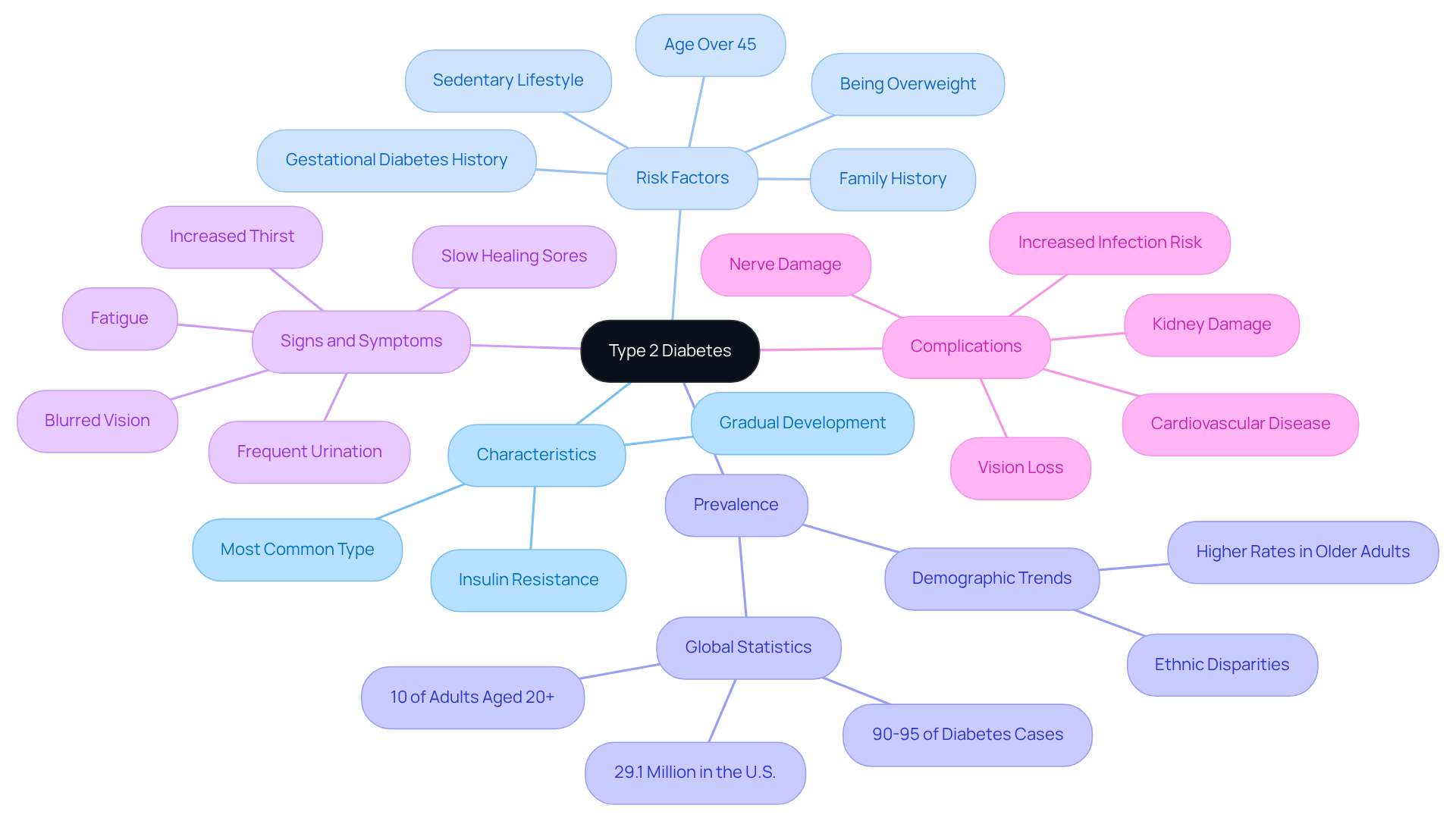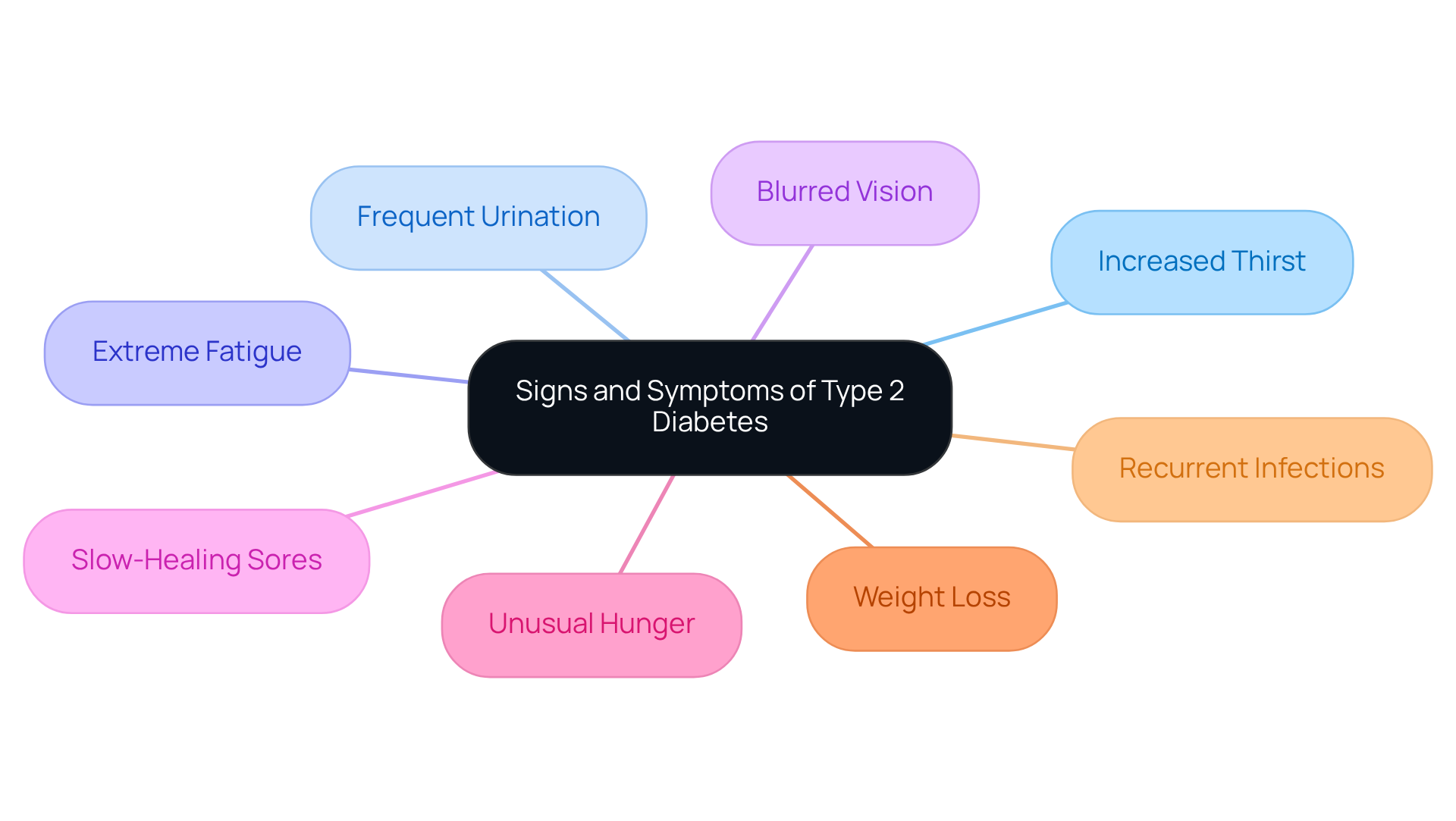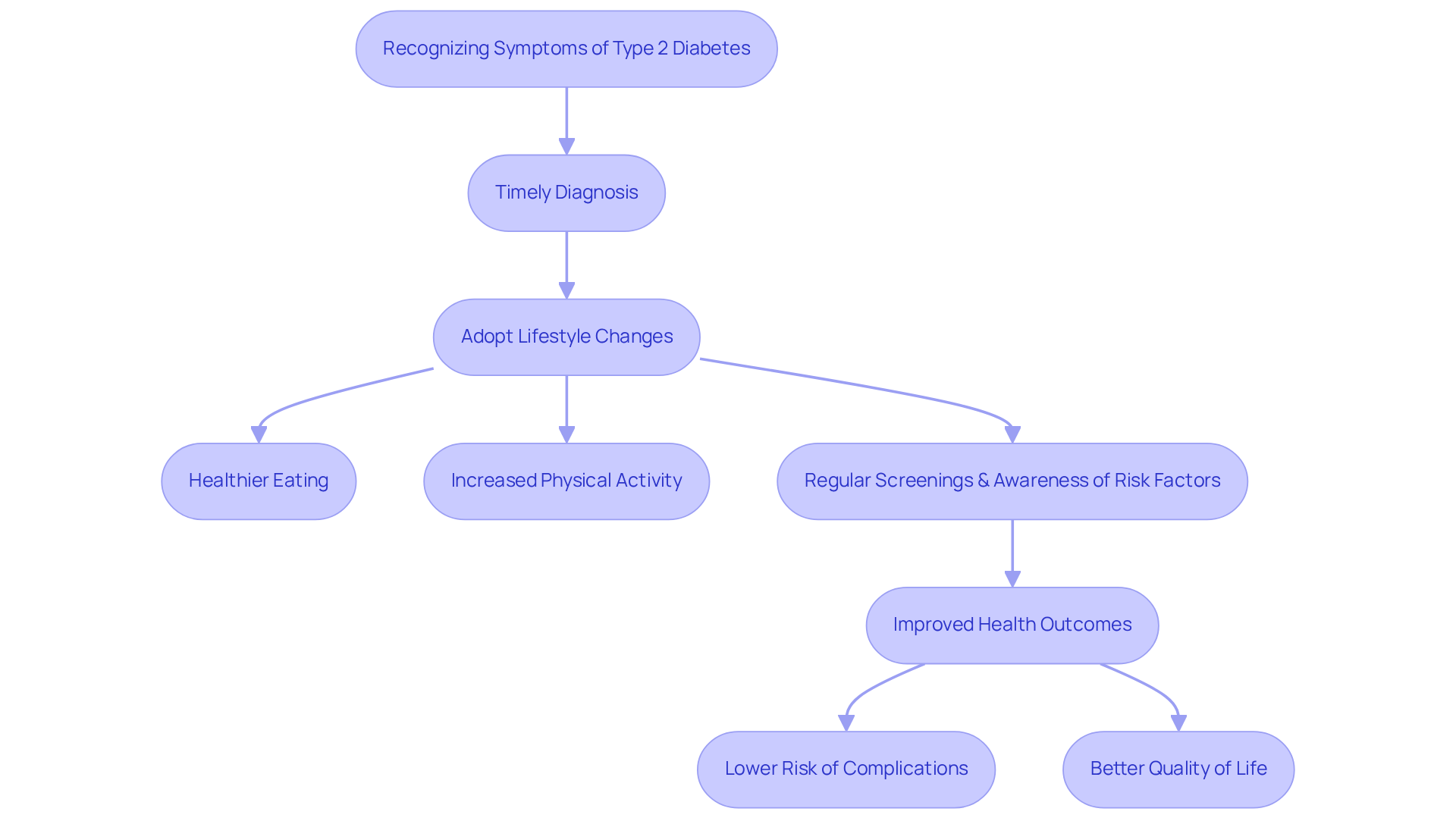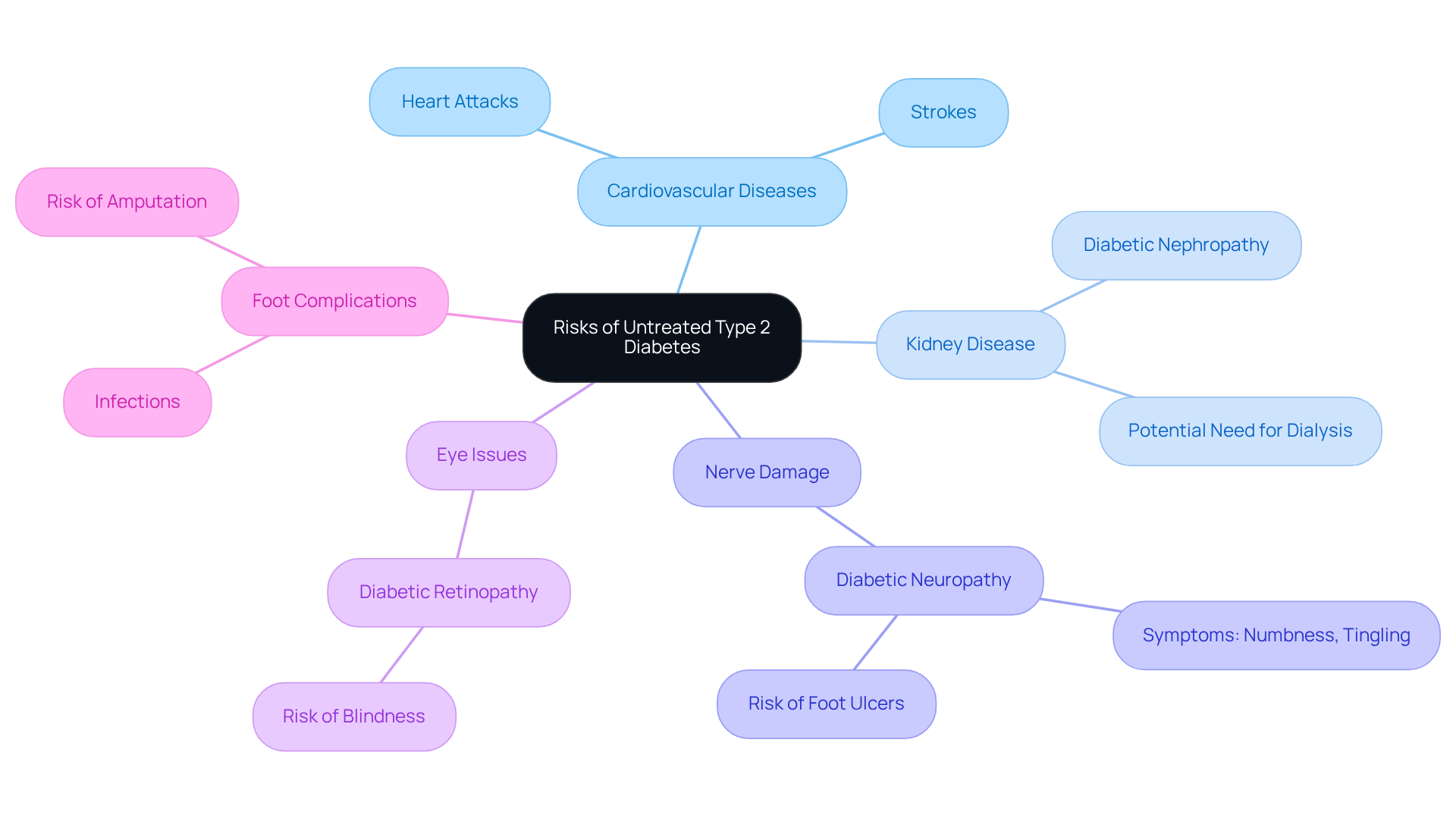Overview
If you’re experiencing increased thirst, frequent urination, extreme fatigue, blurred vision, or slow-healing sores, it’s important to pay attention to these signs. Recognizing the symptoms of Type 2 Diabetes early can be a crucial step in managing your health effectively. Many individuals notice these signs before receiving a diagnosis, which highlights the importance of awareness and timely intervention.
You’re not alone in this journey. Understanding these symptoms is the first step toward taking control of your health. By acting early, you can significantly reduce the risk of serious complications. Remember, seeking support and resources is essential, and there are people who care and want to help you navigate this path. Together, we can work toward better health and well-being.
Introduction
Understanding the signs and symptoms of Type 2 Diabetes is crucial, as this prevalent condition affects millions globally and is often linked to lifestyle choices. By recognizing early indicators such as:
- Increased thirst
- Frequent urination
- Fatigue
you can take proactive steps toward better health management. It's understandable to feel overwhelmed by this information, but acknowledging these signs can empower you on your journey to wellness.
However, the challenge remains: how can one differentiate between normal fatigue and a potential warning sign of a serious health issue? This question is important, and it’s one that many face. This article delves into the key symptoms of Type 2 Diabetes, emphasizing the importance of early detection and timely intervention to prevent serious complications. Remember, you're not alone in this journey; we are here to support you every step of the way.
Define Type 2 Diabetes: Understanding the Condition
Type 2 Diabetes is a long-term metabolic disorder characterized by insulin resistance, so it's important to know what are the signs and symptoms of type 2 diabetes. This means the body struggles to use insulin efficiently, leading to increased blood glucose levels. Unlike Type 1 Diabetes, which is primarily an autoimmune condition, Type 2 Diabetes typically develops gradually. It is often closely linked to lifestyle factors, such as obesity, physical inactivity, and poor dietary habits. It's important to understand what are the signs and symptoms of type 2 diabetes, as this condition is the most common, representing roughly 90-95% of all diabetes cases globally.
Key risk factors include:
- Being overweight
- Leading a sedentary lifestyle
- Having a family history of blood sugar issues
- Being physically inactive less than three times a week
Understanding what are the signs and symptoms of type 2 diabetes is crucial, as it impacts millions worldwide. In fact, over 10% of adults aged 20 and above are diagnosed with this condition. In the United States alone, 29.1 million people have diabetes, with 8.1 million undiagnosed. This highlights how essential awareness and early diagnosis are.
If not managed effectively, the signs and symptoms of type 2 diabetes can lead to serious medical complications, including cardiovascular disease, kidney damage, and vision loss. However, it's comforting to know that regular monitoring and lifestyle modifications can significantly reduce the risk of developing this condition. You're not alone in this journey, and proactive health management can make a meaningful difference. Remember, we are here to support you every step of the way.

Identify Signs and Symptoms: Key Indicators of Type 2 Diabetes
If you're noticing signs like increased thirst, frequent urination, extreme fatigue, blurred vision, or slow-healing sores, it’s important to ask what are the signs and symptoms of type 2 diabetes. You might also find yourself feeling hungrier than usual, losing weight unexpectedly, or dealing with recurrent infections, which raises the question: what are the signs and symptoms of type 2 diabetes? It can be easy to overlook these symptoms, which are what are the signs and symptoms of type 2 diabetes, as they may develop gradually. In fact, studies reveal that around 85% of people with this condition experience what are the signs and symptoms of type 2 diabetes before their diagnosis. This highlights the vital importance of being aware of your body and its signals, particularly what are the signs and symptoms of type 2 diabetes.
For example, one patient shared their experience of feeling unusually fatigued and thirsty for months before finally seeking medical advice. This delay in recognition could have been avoided with better awareness of the symptoms. Endocrinologists emphasize that early detection is crucial; timely intervention can significantly improve management outcomes and lower the risk of complications.
Recognizing these indicators empowers you to take proactive steps in your health journey. Remember, you’re not alone in this journey. T2DSolutions is here to support you, providing education and resources to help you navigate this condition. Together, we can raise awareness and encourage early detection for better long-term health outcomes. Don't hesitate to reach out for support—your health matters, and we are here for you every step of the way.

Emphasize Early Recognition: Importance of Timely Diagnosis and Management
Recognizing what are the signs and symptoms of type 2 diabetes early is vital for effective management and preventing serious complications. It's understandable to feel overwhelmed, but timely diagnosis allows you to adopt lifestyle changes—like healthier eating habits and increased physical activity—that are essential for controlling blood sugar levels. Regular screenings and awareness of risk factors—such as family history and obesity—are crucial for facilitating early detection. Statistics suggest that early intervention can greatly enhance long-term well-being outcomes, lowering the risk of complications like cardiovascular disease, kidney damage, and neuropathy.
For instance, studies show that individuals who make lifestyle adjustments after an early diagnosis can experience notable improvements in their blood sugar control, with some achieving normal glucose levels within months. Furthermore, the latest guidelines recommend routine screenings for adults, particularly those with risk factors, to catch diabetes in its initial stages. Remember, you’re not alone in this journey; health educators emphasize that lifestyle changes not only improve well-being but also empower you to take control of your condition, resulting in a better quality of life.
By prioritizing early recognition and management, you can mitigate the severe impacts of Type 2 Diabetes and foster a healthier future. T2DSolutions is here to assist newly diagnosed patients by offering educational materials, community aid, and tools for effective management of their condition. The economic burden of this condition is significant, with total expenses reaching $412.9 billion in the United States in 2022, highlighting the need for effective management strategies. Additionally, the condition was the eighth leading cause of death in the U.S. in 2021, with 103,294 death certificates listing it as the underlying cause. Notably, 31.9% of adults with diabetes were physically inactive, underscoring the critical role of lifestyle changes in managing the condition. We are here to support you every step of the way.

Explore Complications: Risks of Untreated Type 2 Diabetes
Untreated Type 2 Diabetes can lead to serious medical complications that affect your overall health. These complications may include:
- Cardiovascular diseases, such as heart attacks and strokes
- Kidney disease
- Nerve damage (neuropathy)
- Eye issues like diabetic retinopathy, which can result in blindness
- Foot complications that can lead to infections and even amputations
It's understandable to feel concerned about these risks. Recognizing these potential challenges highlights the importance of consistent monitoring and management of blood sugar levels. By taking proactive steps, you can avoid long-term complications and improve your quality of life.
At T2DSolutions, we are here to support you every step of the way. We provide valuable resources and assistance for newly diagnosed patients, helping you navigate these challenges and improve your health outcomes. Remember, you are not alone in this journey; we are dedicated to helping you find the support you need.

Conclusion
Understanding the signs and symptoms of Type 2 Diabetes is crucial for early detection and effective management of this widespread condition. By recognizing the key indicators, you can take proactive steps to address your health and prevent serious complications. The gradual onset of symptoms such as increased thirst, frequent urination, and fatigue underscores the necessity for awareness and timely intervention.
This article has highlighted the importance of recognizing the risk factors associated with Type 2 Diabetes, including obesity and sedentary lifestyles. It has also emphasized the potential complications that can arise from untreated diabetes, such as cardiovascular disease and kidney damage. The statistics reveal the significant impact of this condition, with millions affected globally. This reinforces the need for regular screenings and lifestyle modifications to manage blood sugar levels effectively.
Ultimately, prioritizing early recognition and management can lead to improved health outcomes and a better quality of life. You're not alone in this journey; individuals are encouraged to stay informed about their health, seek support from resources like T2DSolutions, and make necessary lifestyle changes. By doing so, you can empower yourself to combat Type 2 Diabetes and reduce the risks associated with this serious condition.
Frequently Asked Questions
What is Type 2 Diabetes?
Type 2 Diabetes is a long-term metabolic disorder characterized by insulin resistance, where the body struggles to use insulin efficiently, leading to increased blood glucose levels.
How does Type 2 Diabetes differ from Type 1 Diabetes?
Unlike Type 1 Diabetes, which is primarily an autoimmune condition, Type 2 Diabetes typically develops gradually and is often linked to lifestyle factors.
What are the common risk factors for developing Type 2 Diabetes?
Common risk factors include being overweight, leading a sedentary lifestyle, having a family history of blood sugar issues, and being physically inactive less than three times a week.
How prevalent is Type 2 Diabetes globally?
Type 2 Diabetes represents roughly 90-95% of all diabetes cases globally, affecting over 10% of adults aged 20 and above.
How many people in the United States have diabetes?
In the United States, 29.1 million people have diabetes, with 8.1 million of those being undiagnosed.
What complications can arise from unmanaged Type 2 Diabetes?
If not managed effectively, Type 2 Diabetes can lead to serious medical complications, including cardiovascular disease, kidney damage, and vision loss.
Can Type 2 Diabetes be managed effectively?
Yes, regular monitoring and lifestyle modifications can significantly reduce the risk of developing Type 2 Diabetes and its complications.



